Improved Delayed Detached-Eddy Investigations on the Flow Control of the Leading-Edge Flat Spoiler of the Cavity in the Low-Aspect-Ratio Aircraft
Abstract
:1. Introduction
2. Model Description
3. Numerical Method and Validation
3.1. Numerical Method
3.1.1. Software and Governing Equation
3.1.2. IDDES Method
3.1.3. HLLE++ Scheme
3.1.4. Time Stepping
3.2. Mesh Generation
3.2.1. Generation of Basic Mesh
3.2.2. Grid-Adaptation Method
3.2.3. Conservative Overset Mesh Method
3.3. Verifications and Validations
3.3.1. IDDES Method Verification
3.3.2. Validation of Store Separation
4. Results and Discussion
4.1. The Effects of the Leading-Edge Flat Spoiler to Flow Characteristics
4.1.1. Shear Layers
4.1.2. Pressure Distribution
4.1.3. Large-Scale Vortexes
4.2. The Effects of the Leading-Edge Flat Spoiler on Store Separation
4.3. The Effects of the Leading-Edge Flat Spoiler on Aerodynamic Noise
4.4. The Effects of the Leading-Edge Flat Spoiler on the Aerodynamic Characteristics of the Aircraft
5. Conclusions
Author Contributions
Funding
Data Availability Statement
Conflicts of Interest
Nomenclature
| P∞ | Pressure of freestream flow |
| T∞ | Temperature of freestream flow |
| Mach | Mach number |
| DES | Detached-eddy simulation |
| DDES | Delayed detached-eddy simulation |
| IDDES | Improved delayed-detached-eddy simulation |
| δ | The thickness of the boundary layer |
| Cl | Lift coefficient |
| Cd | Drag coefficient |
| My | Pitching moment coefficient |
| L/D | Lift–drag ratio |
| Volume of the control volume | |
| Conservative state vector | |
| Wall velocity | |
| Outward-pointing normal unit vector | |
| Inviscid flux vector | |
| Viscous flux vector | |
| Density | |
| Total energy | |
| Contravariant velocity | |
| Pressure | |
| Viscous stress | |
| RANS length scale | |
| WMLES length scale | |
| Eigenvalue of HLLE++ | |
| Eigenvalue of HLLE+ | |
| Switching function | |
| Pressure gradient-based switch sensor |
References
- Lawson, S.J.; Barakos, G.N. Review of numerical simulation for high-speed, turbulent cavity flows. Prog. Aerosp. Sci. 2011, 47, 186–216. [Google Scholar] [CrossRef]
- Rudy, A.J.; Michael, J.; James, E.G. Store Separation Trajectory Deviations Due to Unsteady Weapons Bay Aerodynamics. In Proceedings of the 46th AIAA Aerospace Sciences Meeting and Exhibit, Reno, NV, USA, 7–10 January 2008. [Google Scholar]
- Al, H.N.; Kontis, K.; Zare-Behtash, H. The Impact of Steady Blowing from the Leading Edge of an Open Cavity Flow. Aerospace 2021, 8, 255. [Google Scholar]
- Wang, Y.D. Active aerodynamic noise control research for supersonic aircraft cavity by nonlinear numerical simulation. Int. J. Elec. Eng. Educ. 2021. online first. [Google Scholar]
- Zhuang, N.; Alvi, F.S.; Alkislar, M.B.; Shih, C. Supersonic cavity flows and their control. AIAA J. 2006, 44, 2118–2128. [Google Scholar] [CrossRef]
- Takeda, K.; Shieh, C.M. Cavity Tones by Computational Aeroacoustics. Int. J. Comput. Fluid D 2004, 18, 439–454. [Google Scholar] [CrossRef]
- Cattafesta, L.N.; Song, Q.; Williams, D.R.; Rowley, C.W.; Alvi, F.S. Active control of flow-induced cavity oscillations. Prog. Aerosp. Sci. 2008, 44, 479–502. [Google Scholar] [CrossRef]
- Shaw, L. Active control for cavity acoustics. In Proceedings of the 4th AIAA/CEAS Aeroacoustics Conference, Toulouse, France, 2–4 June 1998. [Google Scholar]
- Kim, B.H.; Williams, D.R.; Emo, S.; Acharya, M. Modeling Pulsed-Blowing Systems for Flow Control. AIAA J. 2005, 43, 314–325. [Google Scholar] [CrossRef]
- Smith, B.; Welterlen, T.; Maines, B.; Shaw, L.; Stanek, M.; Grove, J. Weapons bay acoustic suppression from rod spoilers. In Proceedings of the 40th AIAA Aerospace Sciences Meeting & Exhibit, Reno, NV, USA, 14–17 January 2002. [Google Scholar]
- Omer, A.; Arafa, N.; Mohany, A.; Hassan, M. The effect of upstream edge geometry on the acoustic resonance excitation in shallow rectangular cavities. Int. J. Aeroacoust. 2016, 15, 253–275. [Google Scholar] [CrossRef]
- Chen, B.; Wang, Y. Nonlinear Numerical Simulation for Oscillating Pressure in Cavity and Passive Control Research. Int. J. Aerosp. Eng. 2019, 4153287. [Google Scholar] [CrossRef]
- Shaw, L.; Clark, R.; Talmadge, D. F-111 generic weapons bay acoustic environment. J. Aircr. 1988, 25, 147–153. [Google Scholar] [CrossRef]
- Ukeiley, L.S.; Ponton, M.K.; Seiner, J.M.; Jansen, B. Suppression of Pressure Loads in Cavity Flows. AIAA J. 2004, 42, 70–79. [Google Scholar] [CrossRef]
- Saddington, A.J.; Thangamani, V.; Knowles, K. Comparison of Passive Flow Control Methods for a Cavity in Transonic Flow. J. Aircr. 2016, 53, 1439–1447. [Google Scholar] [CrossRef] [Green Version]
- Vakili, A.; Givogue, G.; Fowler, W. An Experimental Investigation of 2-D Cylinders Affecting Supersonic Cavity Flow. In Proceedings of the 29th AIAA Applied Aerodynamics Conference, Honolulu, HI, USA, 27–30 June 2011. [Google Scholar]
- Milne, G.J.; Thieman, C.C.; Vakili, A. An Experimental Investigation of Supersonic Cavity Flow Control with Vertical Cylinders. In Proceedings of the 43rd Fluid Dynamics Conference, San Diego, CA, USA, 24–27 June 2013. [Google Scholar]
- Gai, S.L.; Kleine, H.; Neely, A.J. Supersonic Flow over a Shallow Open Rectangular Cavity. J. Aircr. 2015, 52, 609–616. [Google Scholar] [CrossRef]
- Luo, K.; Zhe, W.; Xiao, Z.; Fu, S. Improved delayed detached-eddy simulations of sawtooth spoiler control before supersonic cavity. Int. J. Heat Fluid Flow 2017, 63, 172–189. [Google Scholar] [CrossRef]
- Schmit, R.; Semmelmayer, F.; Haverkamp, M.; Grove, J.; Ahmed, A. Analysis of Cavity Passive Flow Control Using High Speed Shadowgraph Images. In Proceedings of the 50th AIAA Aerospace Sciences Meeting Including the New Horizons Forum and Aerospace Exposition, Nashville, TN, USA, 9–12 January 2012. [Google Scholar]
- Zhang, P.; Chen, H.; Zhang, J.; Luo, L.; Zhou, F.; Jia, H. The study of passive flow control for weapon bay in high Mach number. J. B Univ. Aeronaut. Astronaut. 2022. [Google Scholar] [CrossRef]
- Freeman, J. Applied Computational Fluid Dynamics for Aircraft-Store Design, Analysis and Compatibility. In Proceedings of the 44th AIAA Aerospace Sciences Meeting and Exhibit, Reno, NV, USA, 9–12 January 2006. [Google Scholar]
- Davis, M.; Yagle, P.; Smith, B.; Chankaya, K.; Johnson, R. Store Trajectory Response to Unsteady Weapons Bay Flowfields. In Proceedings of the 47th AIAA Aerospace Sciences Meeting Including the New Horizons Forum and Aerospace Exposition, Orlando, FL, USA, 5–8 January 2009. [Google Scholar]
- Zhang, Y.; Zhou, N.; Chen, J. Numerical investigation of Reynolds number effects on a low-aspect-ratio flying-wing model. Acta Aerodyn. Sin. 2015, 33, 279–288. [Google Scholar]
- Su, J.; Huang, Y.; Li, Y.; Zhong, S.; Shan, J. Support interference of low-aspect-ratio flying-wing from subsonic to supersonic speed. Acta Aerodyn. Sin. 2015, 33, 289–295. [Google Scholar]
- Su, J.; Huang, Y.; Zhong, S.; Li, Y. Research on flow characteristics of low-aspect-ratio flying-wing at transonic speed. Acta Aerodyn. Sin. 2015, 33, 307–312. [Google Scholar]
- Li, Y.; Liu, H.; Huang, Y.; Zhong, S.; Su, J. Investigation on the correlation of high-speed force test results of flying-wing calibration model with low-aspect ratio. Acta Aerodyn. Sin. 2016, 34, 107–112. [Google Scholar]
- Chen, J.; Wu, X.; Zhang, J.; Li, B.; Jia, H.; Zhou, N. FlowStar: A general unstructured-grid CFD software of National Numerical Windtunnel (NNW) project. Acta Aeronaut. Astronaut. Sin. 2021, 42, 625739. [Google Scholar]
- Tang, J.; Cui, P.; Li, B.; Zhang, Y.; Si, H. Parallel hybrid mesh adaptation by refinement and coarsening. Graph. Models 2020, 111, 101084. [Google Scholar] [CrossRef]
- Tang, J.; Ma, M.; Li, B.; Cui, P. A local and fast interpolation method for mesh deformation. Prog. Comput. Fluid Dyn. 2019, 19, 282–292. [Google Scholar] [CrossRef]
- Tang, J.; Zhang, J.; Li, B.; Zhou, N. Unsteady flow simulation with mesh adaptation. Int. J. Mod. Phys. B 2020, 34, 2040080. [Google Scholar] [CrossRef]
- Tang, J.; Zhang, J.; Li, B.; Cui, P.; Zhou, N. Parallel algorithms for unstructured hybrid mesh adaptation. Acta Aeronaut. Astronaut. Sin. 2020, 41, 123202. [Google Scholar]
- Cui, P.; Li, B.; Tang, J.; Chen, J.; Deng, Y. A modified adjoint-based grid adaptation and error correction method for unstructured grid. Int. J. Mod. Phys. B 2018, 32, 1840020. [Google Scholar] [CrossRef]
- Cui, P.; Deng, Y.; Tang, J.; Li, B. Adjoint equations-based grid adaptation and error correction. Acta Aeronaut. Astronaut. Sin. 2016, 37, 2992–3002. [Google Scholar]
- Venkatakrishnan, V. On the accuracy of limiters and convergence to steady state solutions. In Proceedings of the 31st Aerospace Sciences Meeting, Reno, NV, USA, 11–14 January 1993. [Google Scholar]
- ElCheikh, A.; ElKhoury, M. Effect of Local Grid Refinement on Performance of Scale-Resolving Models for Simulation of Complex External Flows. Aerospace 2019, 6, 86. [Google Scholar] [CrossRef]
- Boudreau, M.; Dumas, G.; Veilleux, J. Assessing the ability of the DDES turbulence modeling approach to simulate the wake of a bluff body. Aerospace 2017, 4, 41. [Google Scholar] [CrossRef]
- Krishnan, V.; Squires, K.; Forsythe, J. Prediction of separated flow characteristics over a hump. AIAA J. 2006, 42, 252–262. [Google Scholar] [CrossRef]
- Wang, H.; Li, J.; Jin, D.; Dai, H.; Gan, T.; Wu, Y. Effect of a transverse plasma jet on a shock wave induced by a ramp. Chin. J. Aeronaut. 2017, 30, 1854–1865. [Google Scholar] [CrossRef]
- Tramel, R.; Nichols, R.; Buning, P. Addition of improved shock-capturing schemes to OVERFLOW 2.1. In Proceedings of the 19th AIAA Computational Fluid Dynamics, San Antonio, TX, USA, 22–25 June 2009. [Google Scholar]
- Zhang, P.; Luo, L.; Jia, H.; Zhao, W.; Zhang, Y.; Wu, X. Application of HLLE++ scheme in the simulation of high mach number cavity flow. Chin. J. Comput. Mech. 2021. Available online: https://kns.cnki.net/kcms/detail/21.1373.O3.20210925.1031.018.html (accessed on 26 September 2021).
- Zhang, P.; Cheng, X.; Chen, H.; Jia, H.; Luo, L.; Tang, Y. Study on unsteady flow mechanism of high Mach number cavity. J. B Univ. Aeronaut. Astronaut. 2022. [Google Scholar] [CrossRef]
- McDaniel, D.R.; Nichols, R.H.; Eymann, T.A.; Starr, R.E.; Morton, S.A. Accuracy and Performance Improvements to Kestrel’s Near-Body Flow Solver. In Proceedings of the 54th AIAA Aerospace Sciences Meeting, San Diego, CA, USA, 4–8 January 2016. [Google Scholar]
- Bond, R.B.; Nichols, R.; Power, G.D. Extension of Kestrel to General Thermochemical Models, Part, I. In Proceedings of the 46th AIAA Thermophysics Conference, Washington, DC, USA, 13–17 June 2016. [Google Scholar]
- Blazek, J. Computational Fluid Dynamics: Principles and Applications, 1st ed.; Elsevier: Oxford, UK, 2001; pp. 181–216. [Google Scholar]
- Tang, J.; Cui, P.; Jia, H.; Li, B.; Li, H. Robust adaptation techniques for unstructured hybrid mesh. Acta Aeronaut. Astronaut. Sin. 2019, 40, 122894. [Google Scholar]
- Cui, P.; Chen, J.; Li, B.; Li, H.; Ma, M.; Tang, J. A wide-template and high-accuracy data transfer method for unstructured adjoint-based grid adaptation. J. Phys. Conf. Ser. 2021, 1985, 012021. [Google Scholar] [CrossRef]
- Aref, P.; Ghoreyshi, M.; Jirasek, A.; Seidel, J. Application of the HPCMP CREATETM-AV Kestrel to an Integrated Propeller Prediction. Aerospace 2020, 7, 177. [Google Scholar] [CrossRef]
- Cui, P.; Li, B.; Tang, J.; Gong, X.; Ma, M. An improved tri-linear interpolation method for hybrid overset grids and its application. In Proceedings of the Asia-Pacific International Symposium on Aerospace Technology, Chengdu, China, 16–18 October 2018. [Google Scholar]
- Cui, P.; Tang, J.; Li, B.; Ma, M.; Deng, Y. Conservative interpolation method of overlapping grids based on super grids. Acta Aeronaut. Astronaut. Sin. 2018, 39, 121596. [Google Scholar]
- Mancini, S.; Kolb, A.; Gonzalez-Martino, I.; Casalino, D. Very-Large Eddy Simulations of the M219 Cavity at High-Subsonic and Supersonic Conditions. In Proceedings of the AIAA Scitech 2019 Forum, San Diego, CA, USA, 7–11 January 2019. [Google Scholar]
- Lyubimov, D.; Fedorenko, A. External flow velocity and synthetic jets parameters influence on cavity flow structure and acoustics characteristics using RANS/ILES. Int. J. Aeroacoust. 2018, 17, 259–274. [Google Scholar] [CrossRef]
- Yan, P.; Zhang, Q.; Li, J. Numerical study of strong interplay between cavity and store during launching. J. Mech. 2018, 34, 103–112. [Google Scholar] [CrossRef]
- Mancini, S.; Kolb, A.; Gonzalez-Martino, I.; Casalino, D. Predicting high-speed feedback mechanisms in rectangular cavities using lattice-Boltzmann very-large eddy simulations. Aerosp. Sci. Technol. 2021, 117, 106908. [Google Scholar] [CrossRef]
- Allen, R.; Mendonca, F. DES Validations of Cavity Acoustics over the Subsonic to Supersonic Range. In Proceedings of the 10th AIAA/CEAS Aeroacoustics Conference, Manchester, UK, 10–12 May 2004. [Google Scholar]
- Meakin, R. Computations of the unsteady flow about a generic wing/pylon/finned-store configuration. In Proceedings of the Astrodynamics Conference, Hilton Head Island, SC, USA, 10–12 August 1992. [Google Scholar]


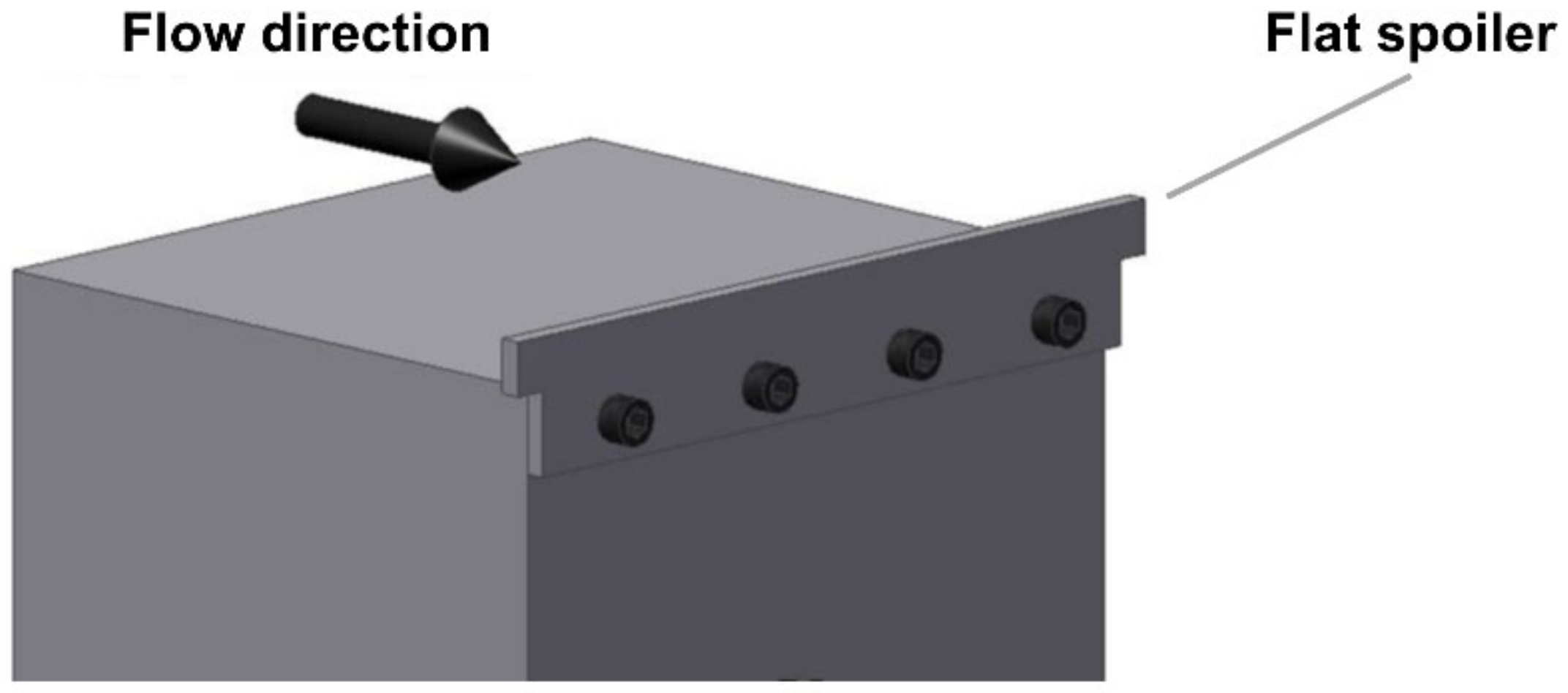
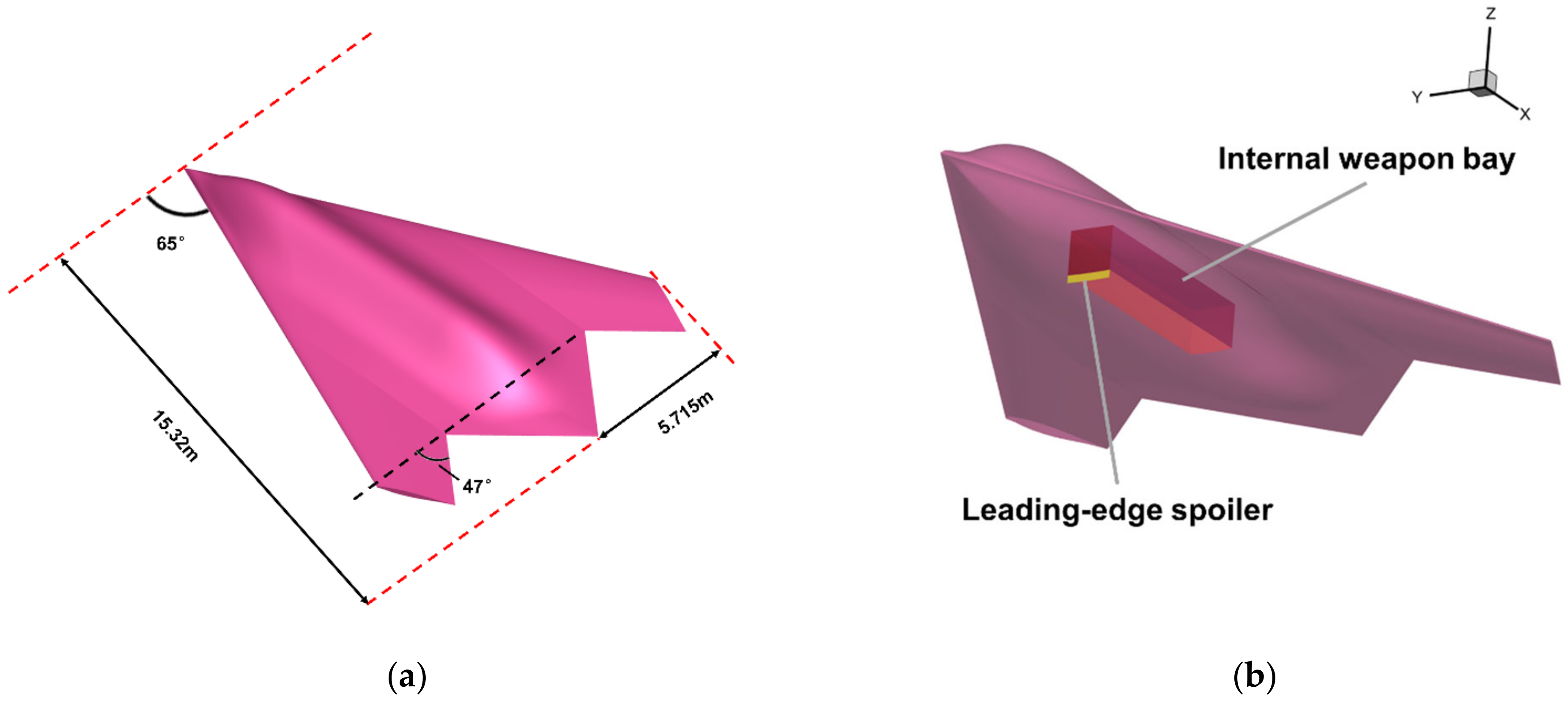

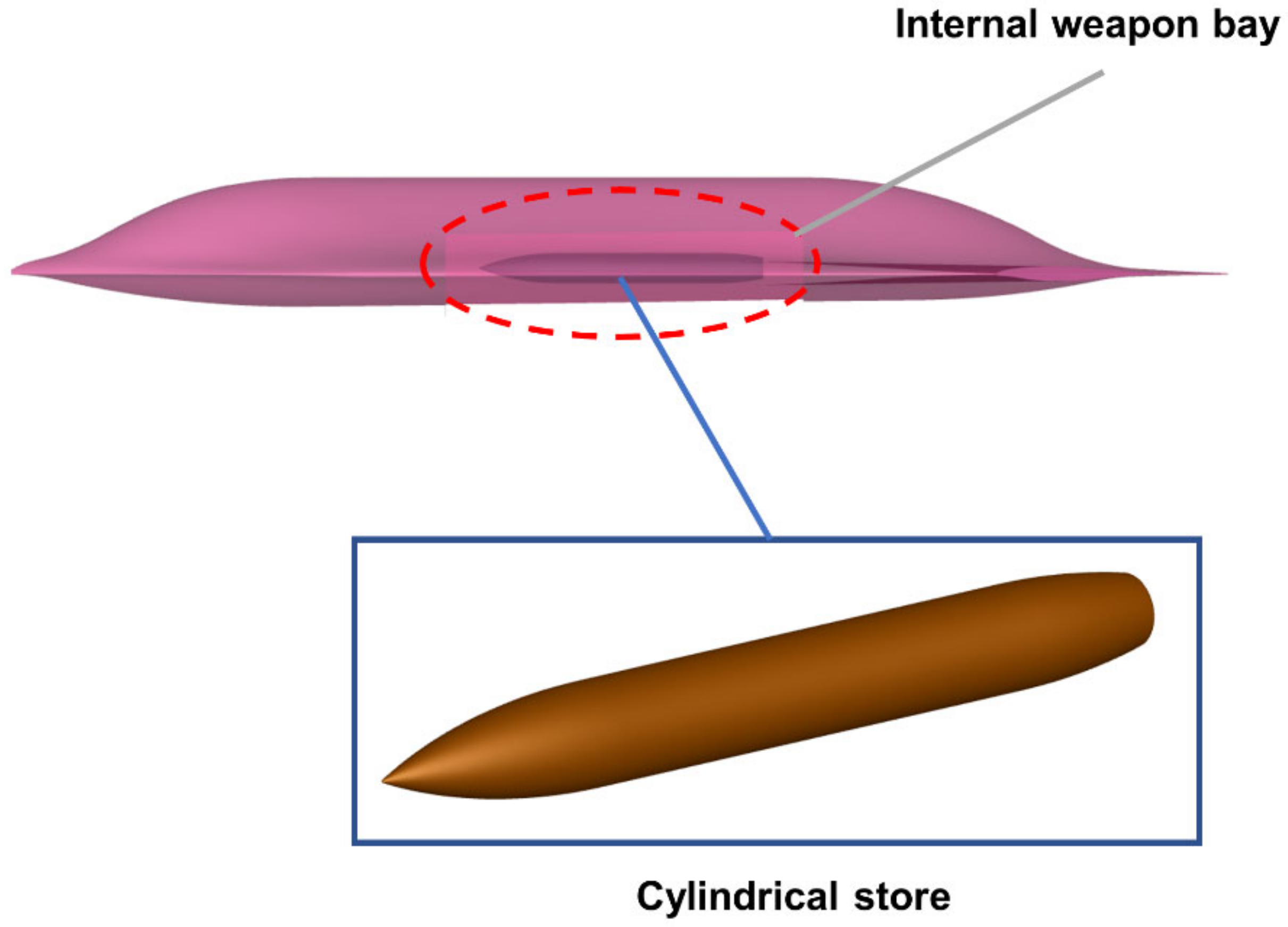

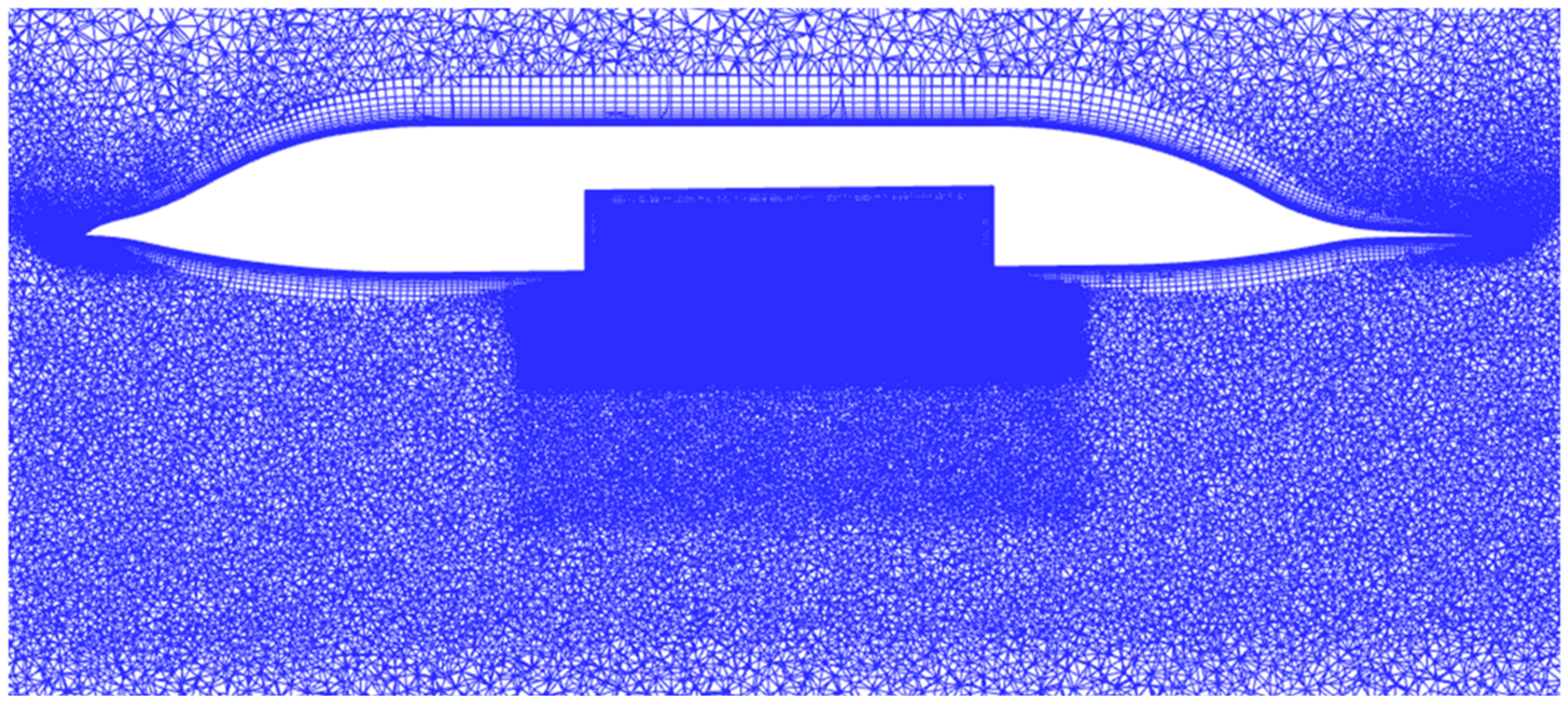



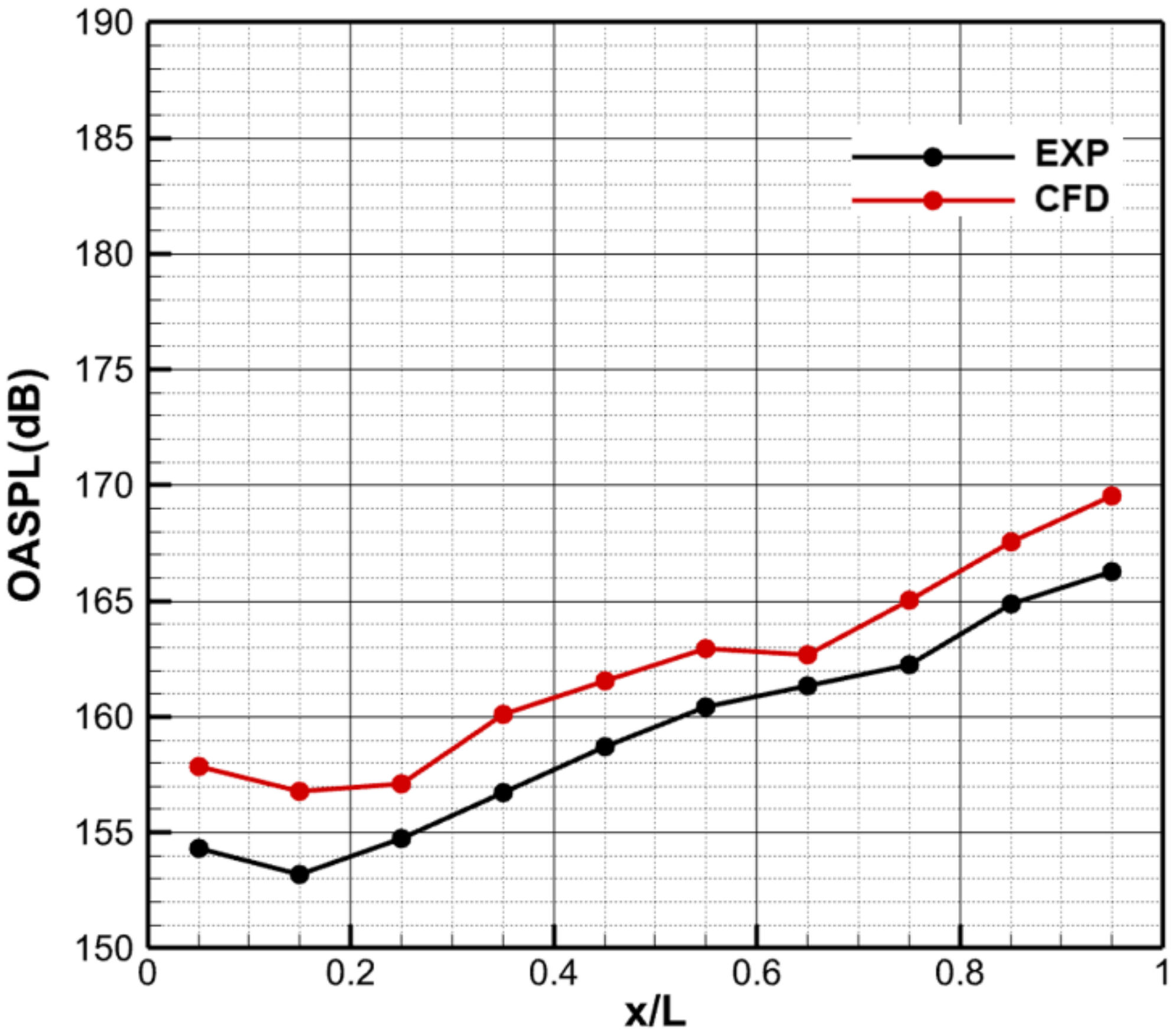

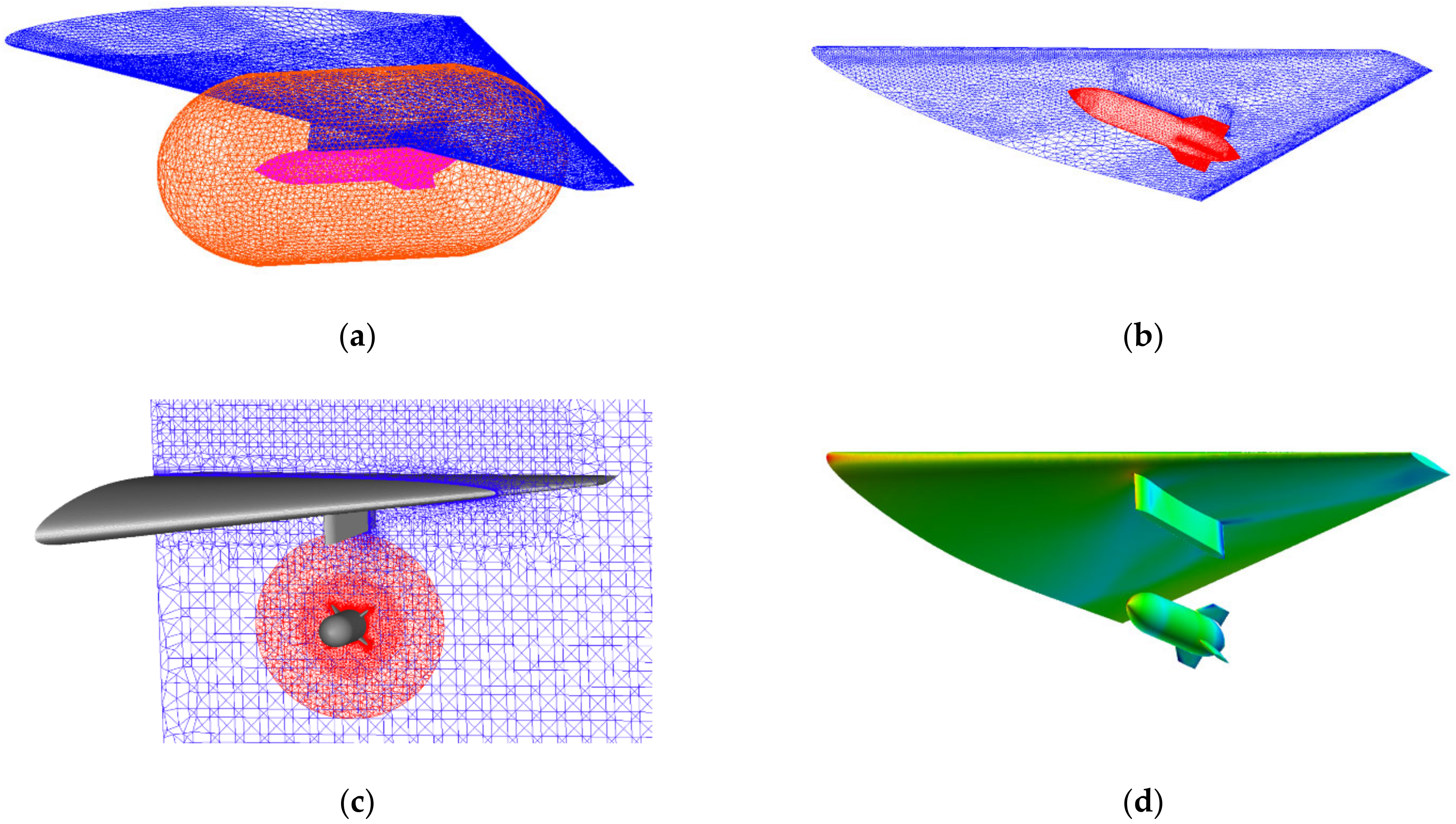
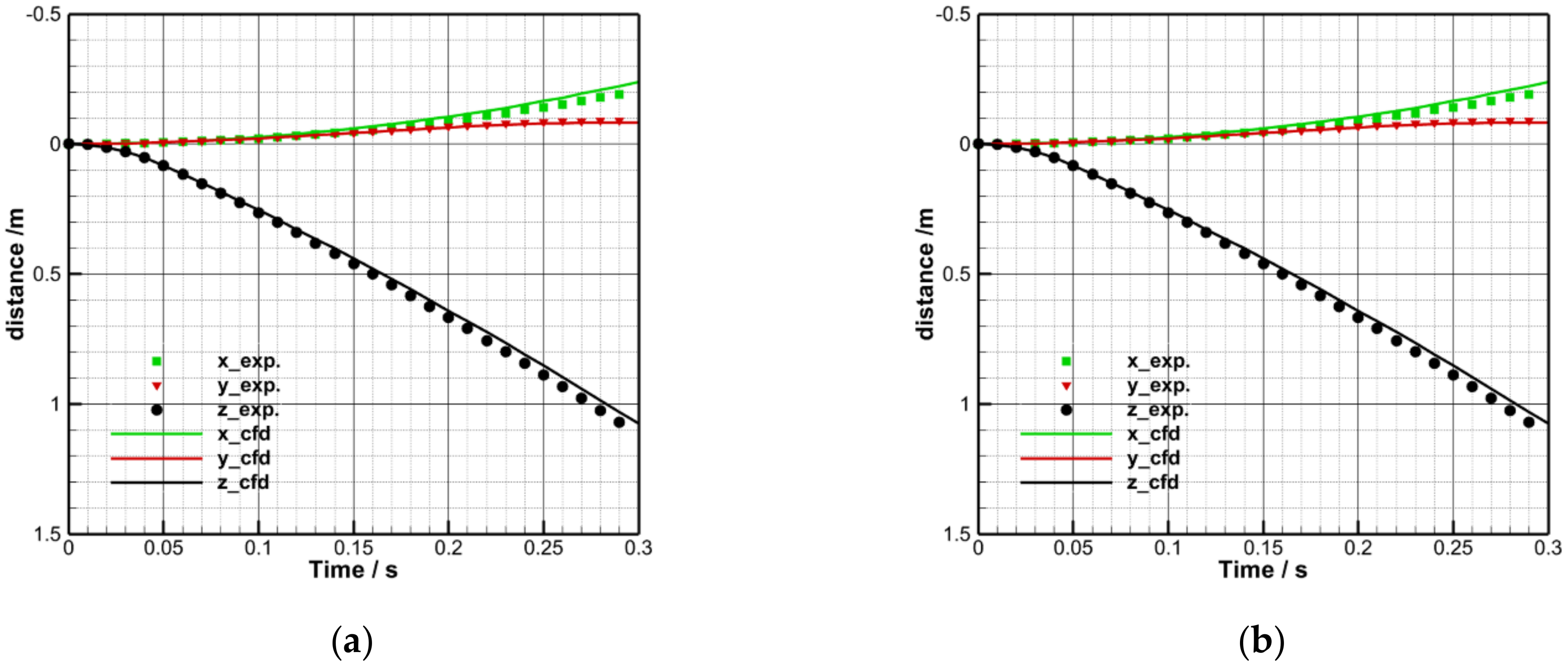
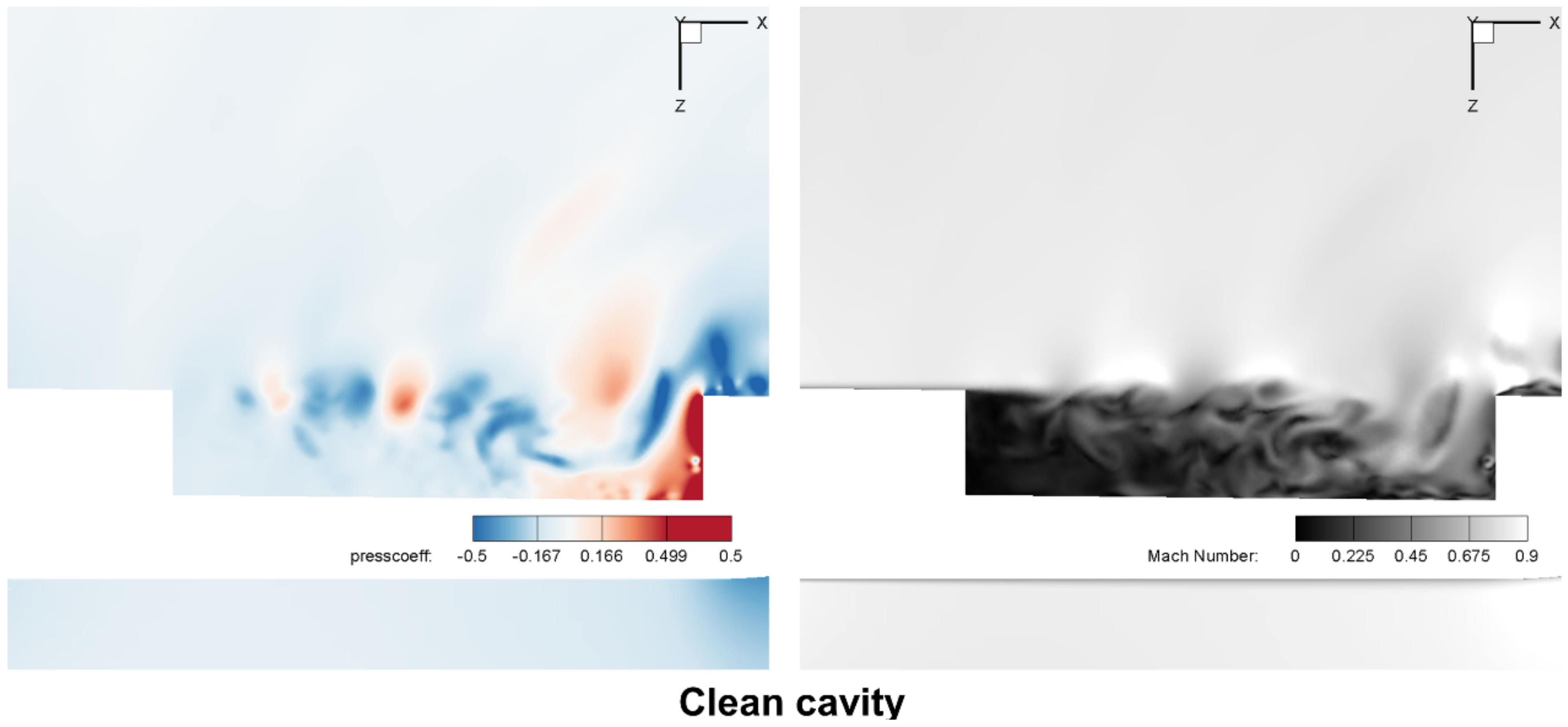
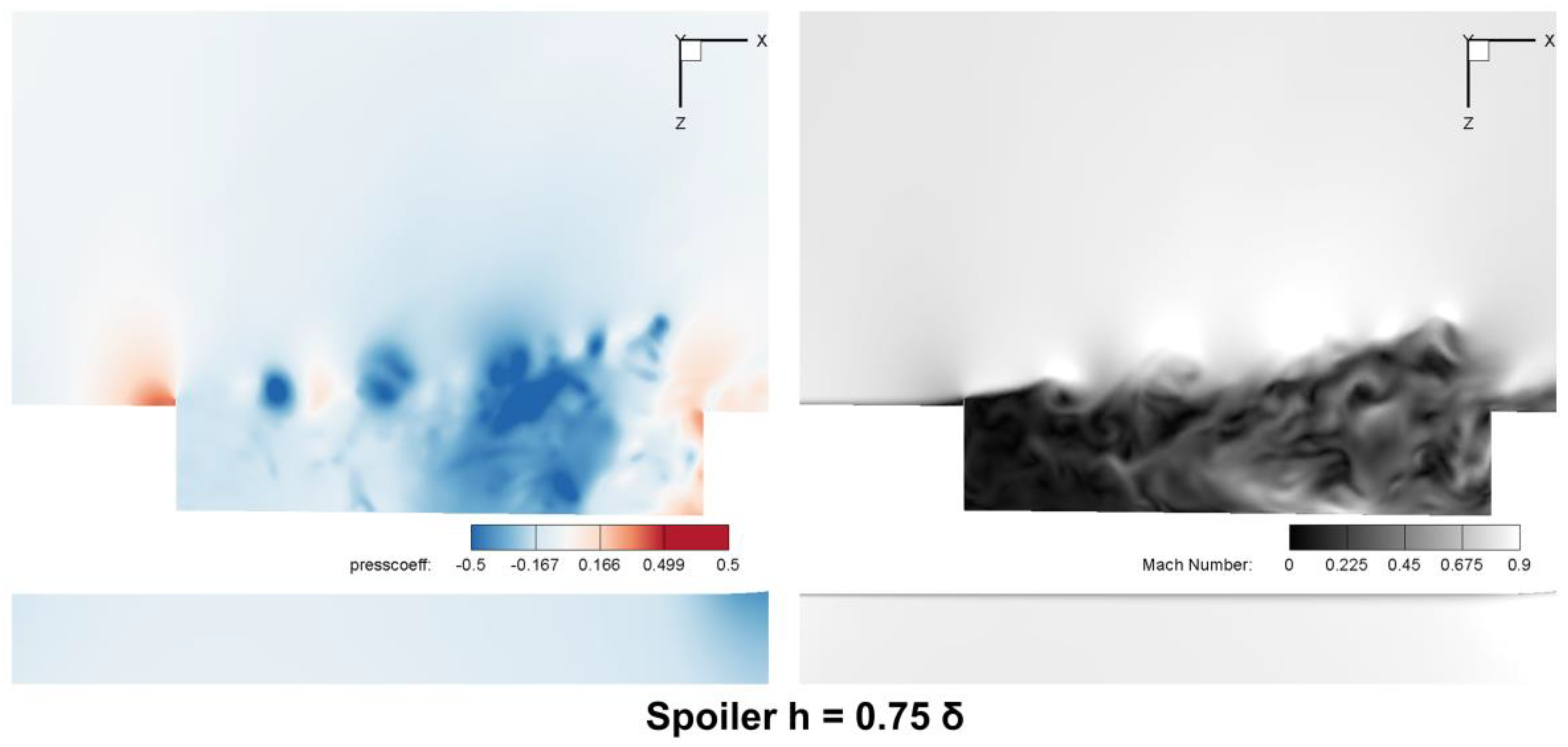
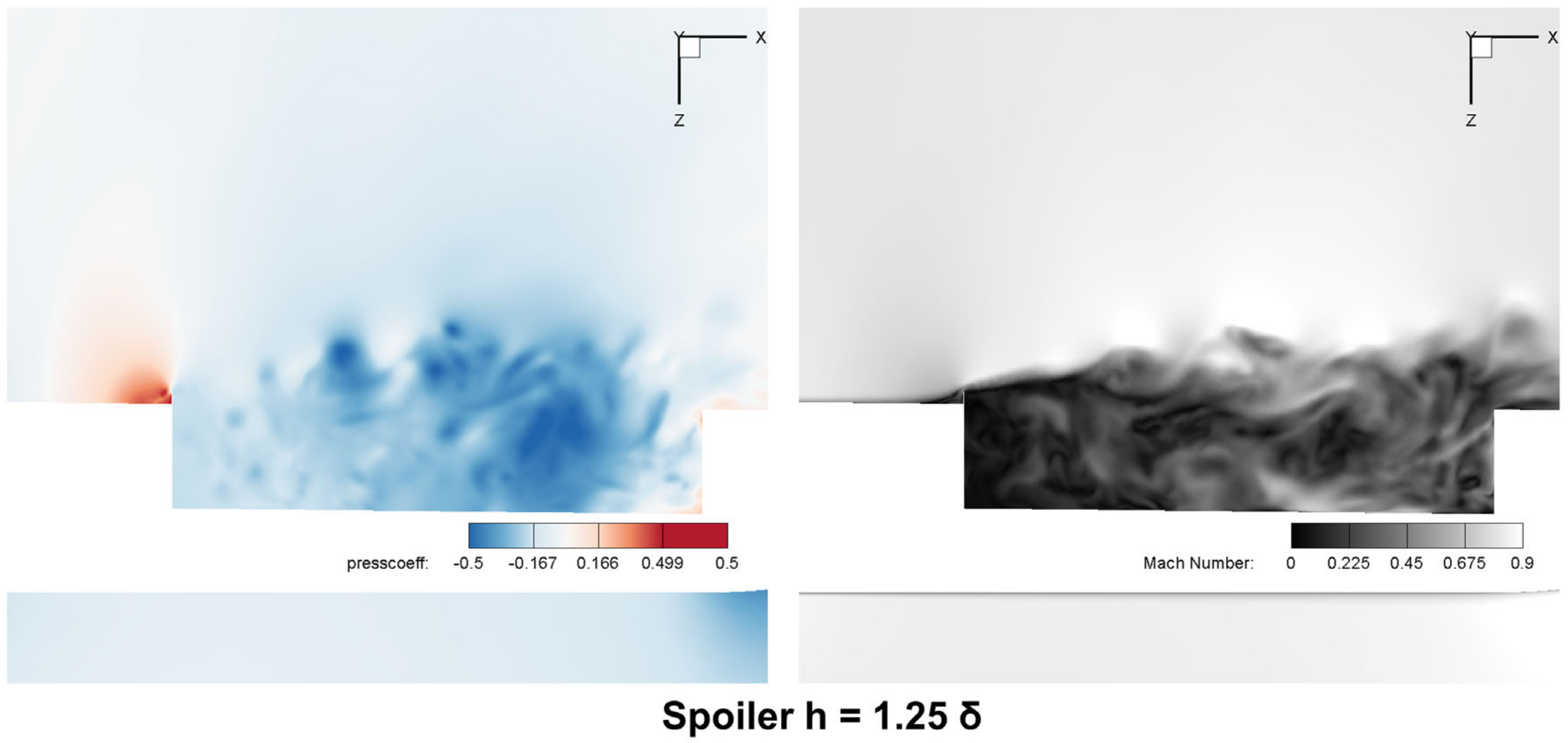
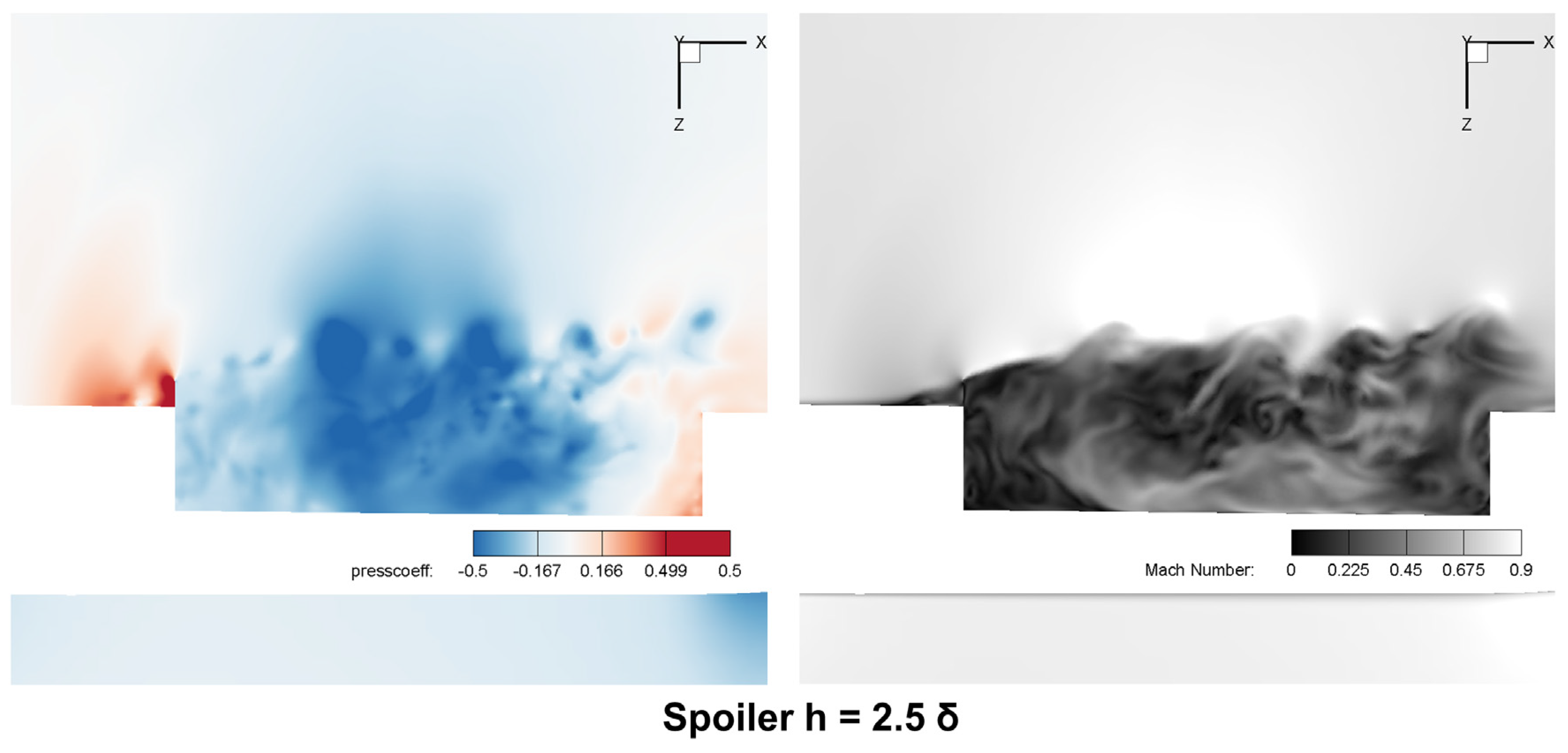
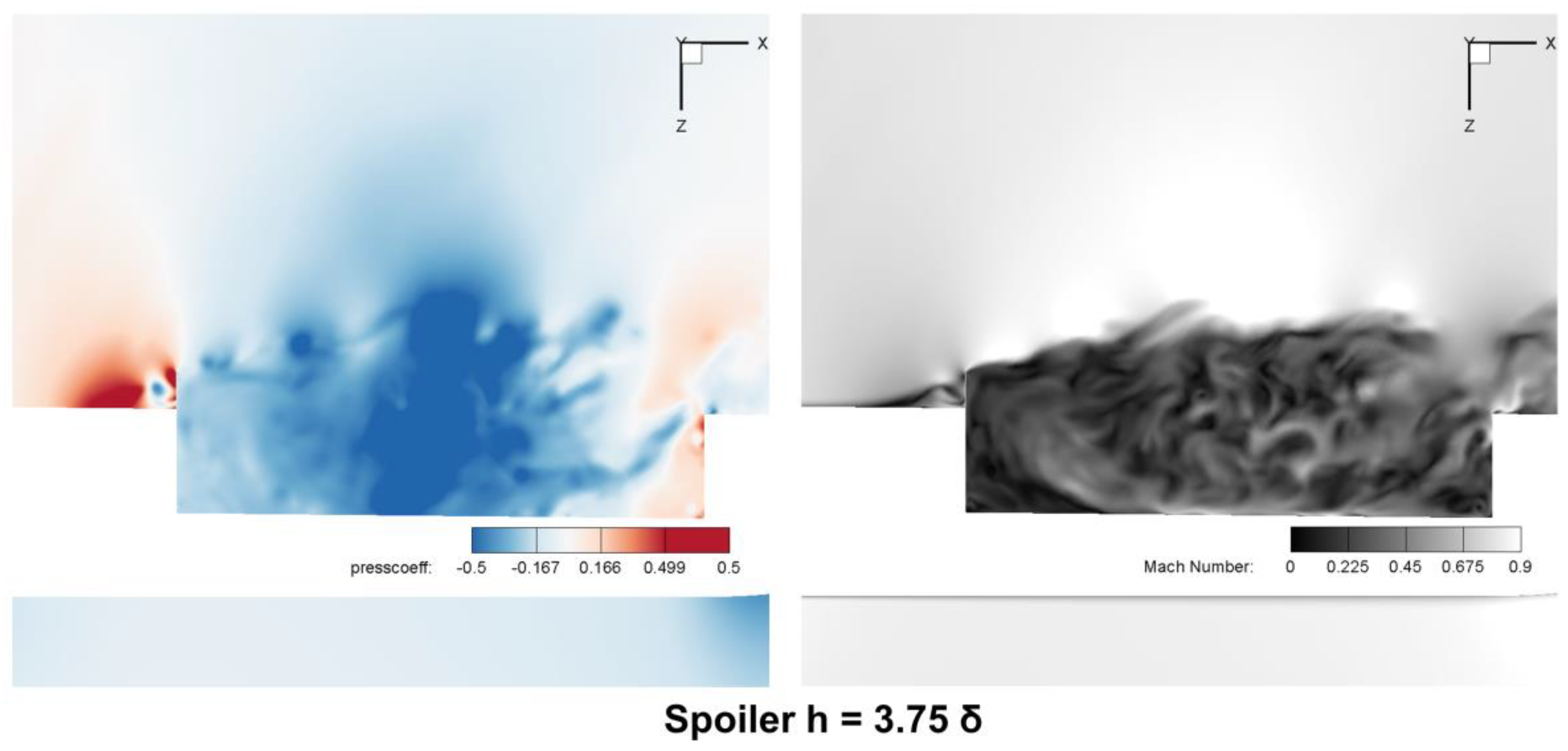
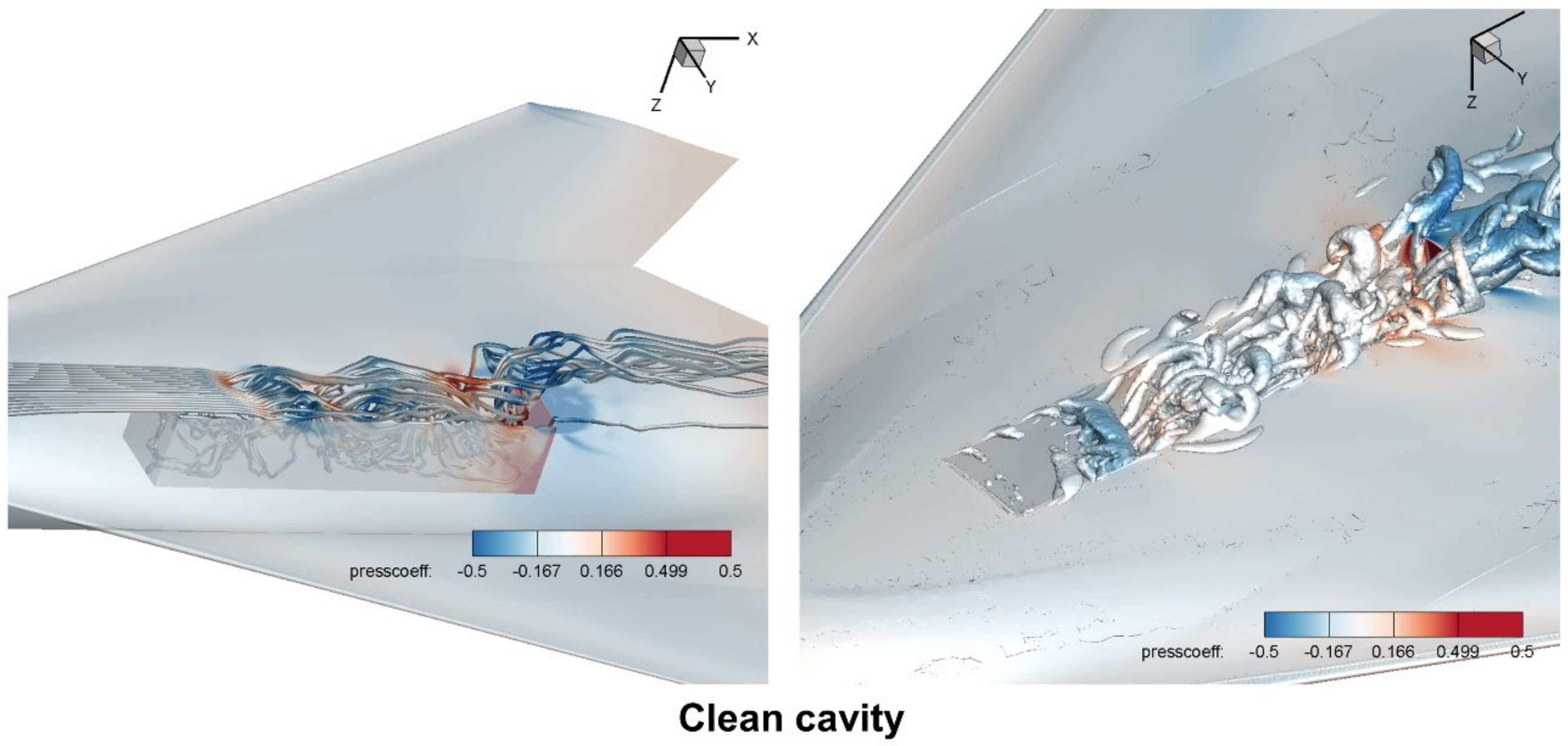

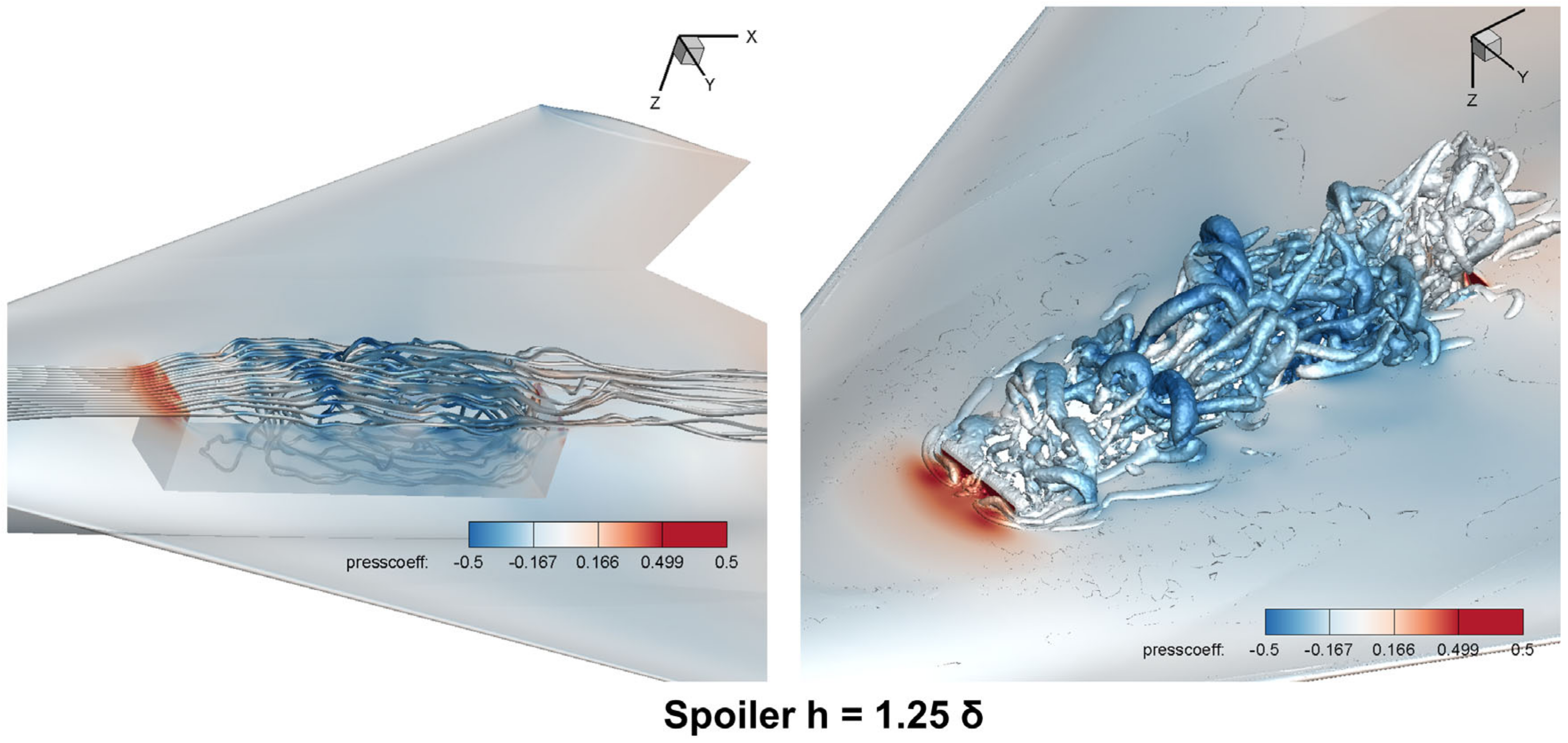

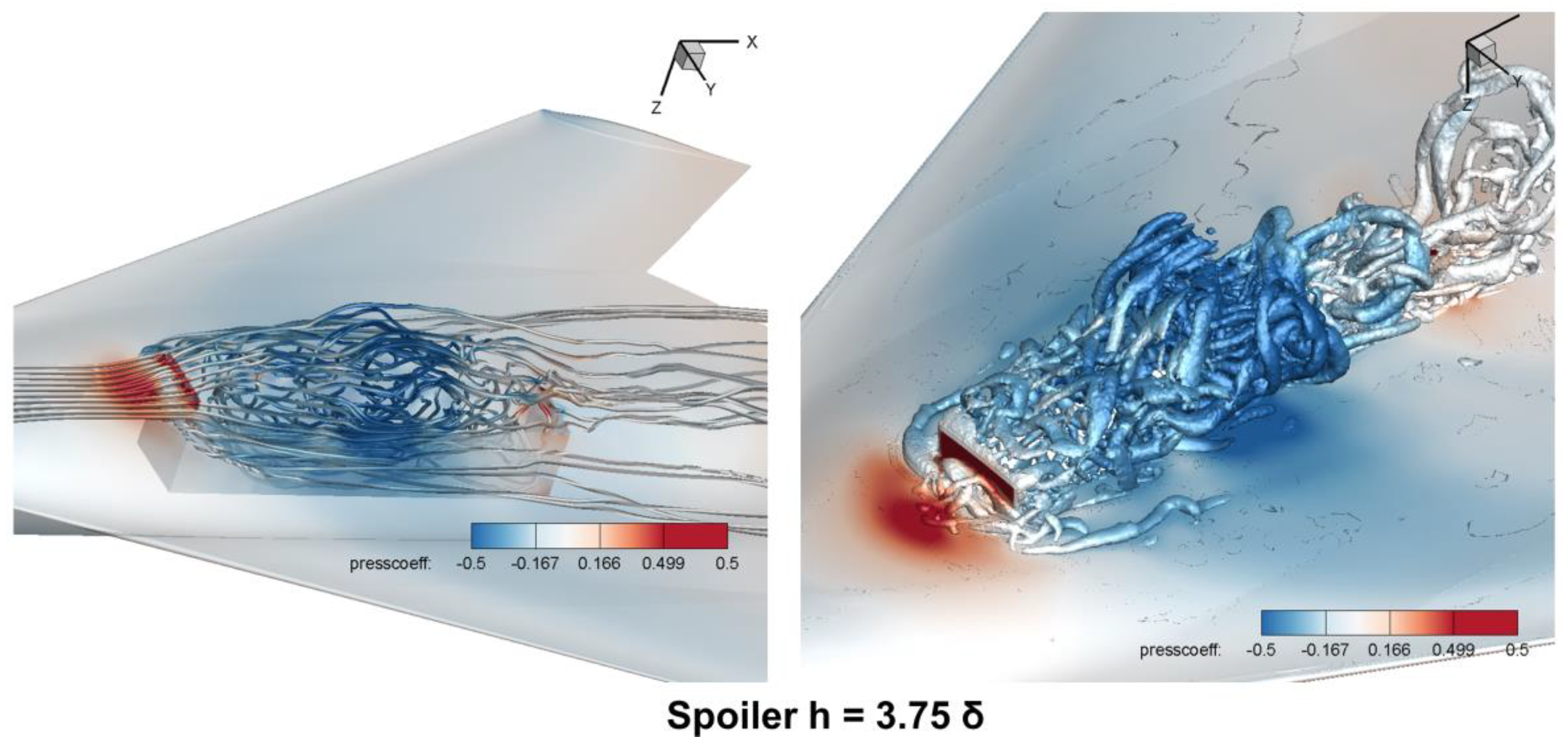



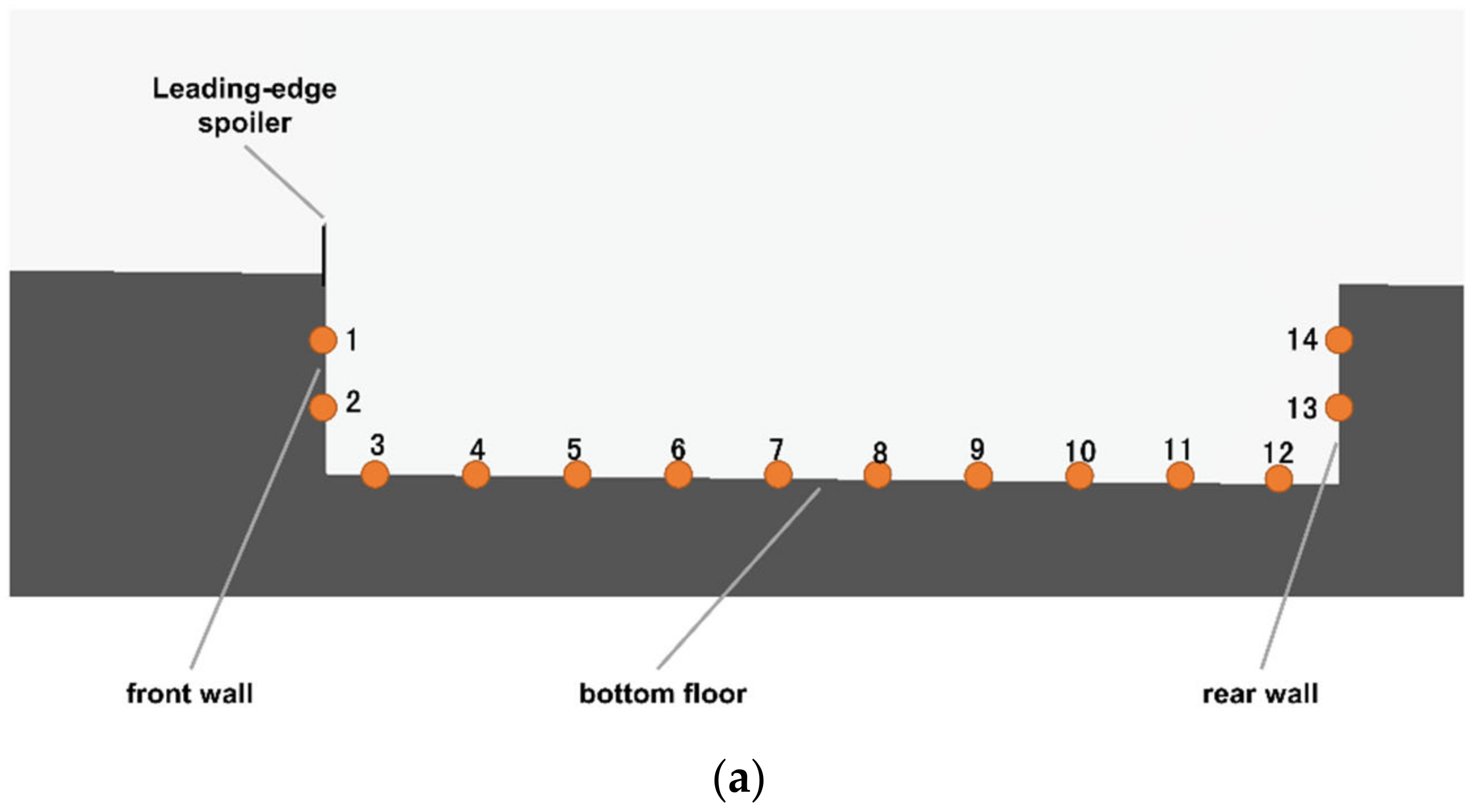

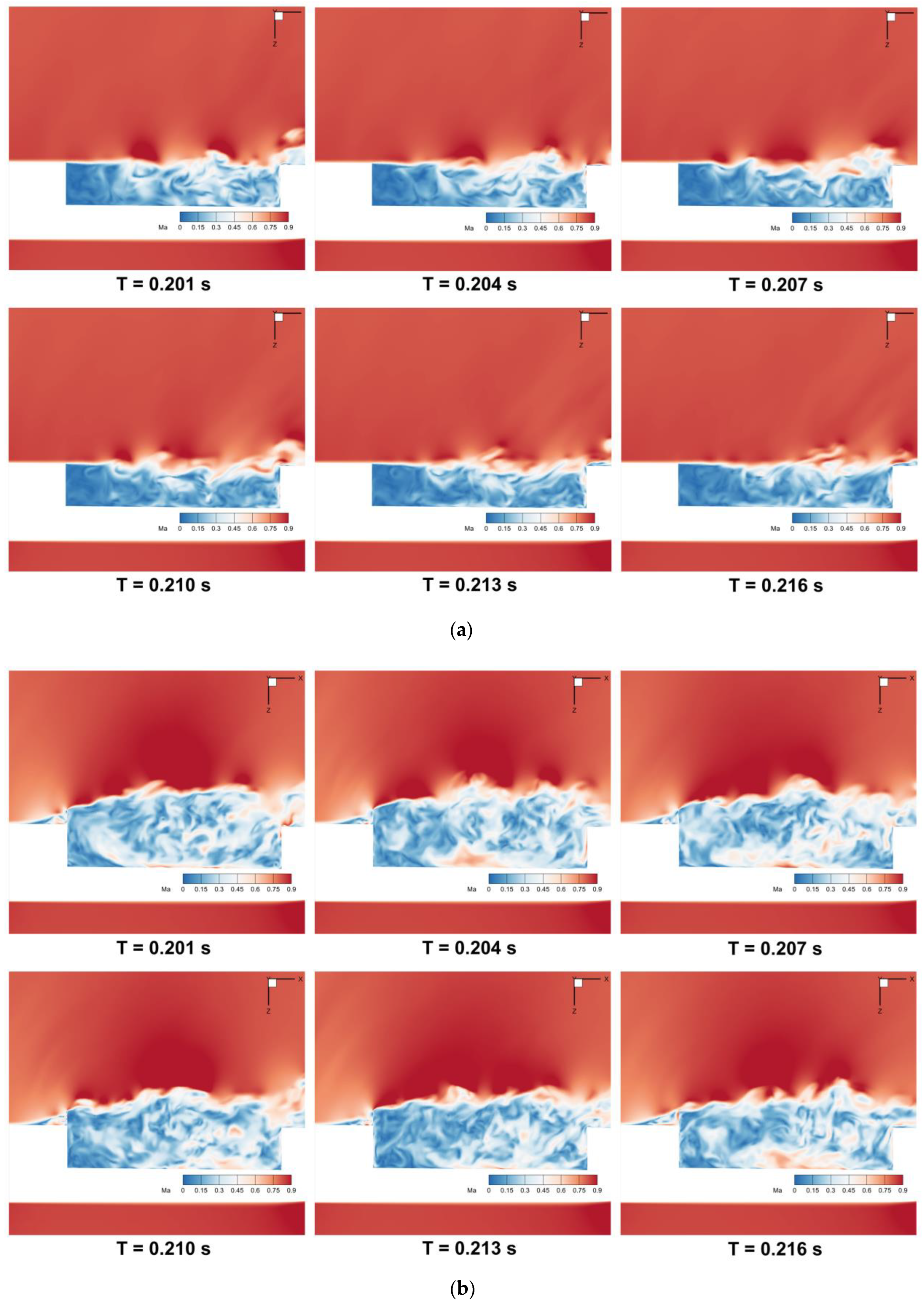

| P∞ | T∞ | Altitude | Mach | Attack Angle | Sideslip Angle |
|---|---|---|---|---|---|
| 26,499.9 Pa | 223.252 K | 10 km | 0.8 | 0 | 0 |
Publisher’s Note: MDPI stays neutral with regard to jurisdictional claims in published maps and institutional affiliations. |
© 2022 by the authors. Licensee MDPI, Basel, Switzerland. This article is an open access article distributed under the terms and conditions of the Creative Commons Attribution (CC BY) license (https://creativecommons.org/licenses/by/4.0/).
Share and Cite
Cui, P.; Zhou, G.; Zhang, Y.; Jia, H.; Wu, X.; Ma, M.; Li, H.; Chen, B. Improved Delayed Detached-Eddy Investigations on the Flow Control of the Leading-Edge Flat Spoiler of the Cavity in the Low-Aspect-Ratio Aircraft. Aerospace 2022, 9, 526. https://doi.org/10.3390/aerospace9090526
Cui P, Zhou G, Zhang Y, Jia H, Wu X, Ma M, Li H, Chen B. Improved Delayed Detached-Eddy Investigations on the Flow Control of the Leading-Edge Flat Spoiler of the Cavity in the Low-Aspect-Ratio Aircraft. Aerospace. 2022; 9(9):526. https://doi.org/10.3390/aerospace9090526
Chicago/Turabian StyleCui, Pengcheng, Guiyu Zhou, Yaobing Zhang, Hongyin Jia, Xiaojun Wu, Mingsheng Ma, Huan Li, and Bing Chen. 2022. "Improved Delayed Detached-Eddy Investigations on the Flow Control of the Leading-Edge Flat Spoiler of the Cavity in the Low-Aspect-Ratio Aircraft" Aerospace 9, no. 9: 526. https://doi.org/10.3390/aerospace9090526
APA StyleCui, P., Zhou, G., Zhang, Y., Jia, H., Wu, X., Ma, M., Li, H., & Chen, B. (2022). Improved Delayed Detached-Eddy Investigations on the Flow Control of the Leading-Edge Flat Spoiler of the Cavity in the Low-Aspect-Ratio Aircraft. Aerospace, 9(9), 526. https://doi.org/10.3390/aerospace9090526




